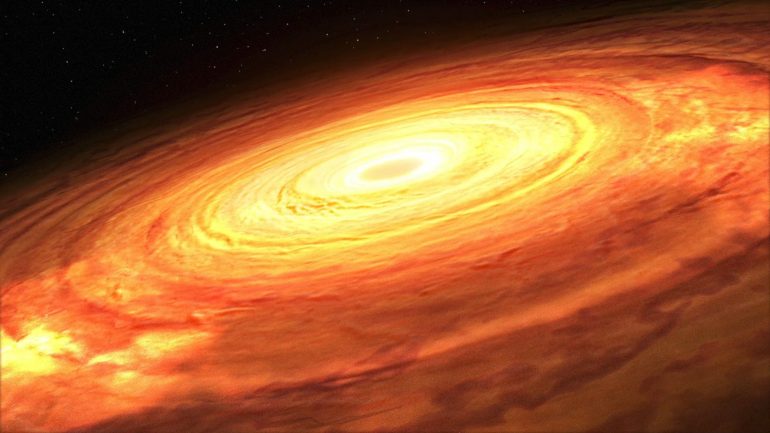How massive are the supermassive black holes, which are mostly invisible at the heart of galaxies? According to one study, the twinkle of light from the disk of matter around such black holes reflects their mass. This connection provides a new way to image mysterious gravitational giants with the aid of optical observations. Astronomers say the method could also help better understand poorly understood processes in accretion disks.
Their gravitational force is so strong that not even light escapes them: because of their spectacular physical characteristics and cosmic significance, black holes are a special focus of astrophysics. One estimated their mass by their effect on the environment. These fall into three categories. There are stellar black holes with masses up to ten times the mass of the Sun, medium-mass specimens that weigh about 100 to 100,000 times that of our Sun, and then there are the absolute gravity monsters: super-massive black holes millions of billions of times more massive than the Sun. are massive and are usually located at the center of galaxies.
The giants among black holes in particular still pose many puzzles to astronomers. It is also unclear how they form and grow. To investigate this question, it would be beneficial to be able to use some other method to determine their mass. A research team led by the University of Illinois at Urbana-Champaign is now showing such a possibility. Astronomers initially focused on the active supermassive black holes (SMBHs) at the center of galaxies – or the disks of matter from which they “feed”. These accretion disks are about the size of our solar system and can emit strong radiation due to “eating” processes. Often it can even outweigh the brightness of the entire galaxy.
Are there characteristic patterns in Flicker?
It is known that the light of “hole linings” flickers: due to physical processes that are not yet fully understood, radiation fluctuates over time, ranging from hours to decades. “An attempt has been made to establish a relationship between the flicker and the mass of the SMBH, but the results were inconclusive,” says first author Colin Burke. For their study, he and his colleagues have compiled a data set of 67 active SMBHs with known masses to be able to analyze the variability patterns of radiation more comprehensively.
As the researchers report, they are now able to identify patterns that clearly show a relationship between the flicker and the mass of the SMBH: they determined a specific time course in the flicker that corresponds to the known characteristics of the associated black hole. closely related with. He then expanded his investigation to include growing white dwarf stars, which may also have twinkling accretion disks. These are the remnants of stars from the mass of our Sun. The scientists found that similar flicker-to-mass ratios also exist in these celestial bodies, although white dwarfs are millions to billions of times less massive than SMBHs.
potential for astronomy
“These results suggest that the flicker processes during accretion are universal – regardless of whether the central object is a supermassive black hole or a very light white dwarf,” says co-author Yu Shen. His colleague Yan-Fei Jiang from the Center for Computational Astrophysics in New York says: “The relationship between the observed light flicker and the fundamental properties of the center may help us better understand the accretion processes.”
As the scientists explain, the results may, above all, shed light on the hitherto rarely discovered medium-sized black hole (IMBH): “Now that the correlation is clear, we can infer that medium-sized shockwaves signal What are the samples might look like,” Burke says. In this context, scientists are now expecting data from the sky survey by the Legacy Survey of Space and Time (LSST) project from the end of 2023. IMBH has the potential to discover and study this long-sought mysterious population of black holes,” says co-author Xin Liu of the University of Illinois.
Video: Artist’s impression of the twinkling of light in a supermassive black hole. (Credit: Mark A. Garlic/Simons Foundation)
Source: University of Illinois at Urbana-Champaign, Article: Science, DOI: 10.1126/science.abg9933

Web guru. Amateur thinker. Unapologetic problem solver. Zombie expert. Hipster-friendly travel geek. Social mediaholic.





